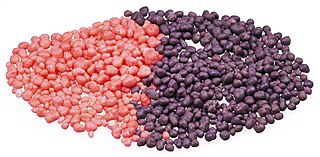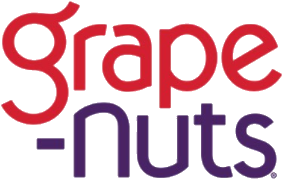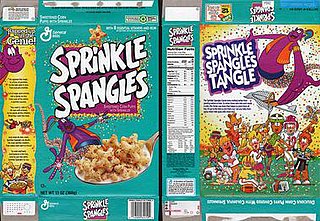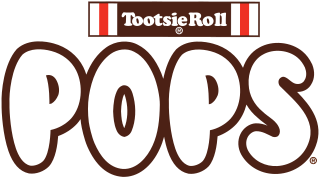
Lucky Charms is a brand of breakfast cereal produced by General Mills since 1964. The cereal consists of multi-colored marshmallows and pieces of shaped pulverized oat, each resembling one of several objects or symbols associated with good luck. The packaging and marketing features a leprechaun mascot, Lucky.

Cap'n Crunch is a corn and oat breakfast cereal manufactured since 1963 by Quaker Oats Company, a subsidiary of PepsiCo since 2001. Since the original product introduction, marketed simply as Cap'n Crunch, Quaker Oats has since introduced numerous flavors and seasonal variations, some for a limited time—and currently offers a Cap'n Crunch product line.

General Mills, Inc., is an American multinational manufacturer and marketer of branded processed consumer foods sold through retail stores. Founded on the banks of the Mississippi River at Saint Anthony Falls in Minneapolis, the company originally gained fame for being a large flour miller. Today, the company markets many well-known North American brands, including Gold Medal flour, Annie's Homegrown, Lärabar, Cascadian Farm, Betty Crocker, Yoplait, Nature Valley, Totino's, Pillsbury, Old El Paso, Häagen-Dazs, as well as breakfast cereals under the General Mills name, including Cheerios, Wheaties, Chex, Lucky Charms, Trix, Cocoa Puffs and Count Chocula and the other monster cereals.

Nutri-Grain is a brand of breakfast cereal and breakfast bar made by Kellanova. In Australia and New Zealand Nutri-Grain is a breakfast cereal made from corn, oats, and wheat. The pieces are shaped like bricks.

Pop-Tarts is an American brand of toaster pastries produced and distributed by Kellanova since 1964, consisting of a sweet filling sealed inside two layers of thin, rectangular pastry crust. Most varieties are also frosted. Although sold precooked, they are designed to be warmed inside a toaster or microwave oven. They are usually sold in pairs inside Mylar packages and do not require refrigeration.

Apple Jacks is an American brand of breakfast cereal that is produced by both successors to the original Kellogg's—WK Kellogg Co in the United States, Canadian, and Caribbean markets and Kellanova in the rest of the world. It was introduced to the U.S. as "Apple O's" in 1965 after being invented by college intern William Thilly. In 1971 the name "Apple Jacks" was put into action by advertisers. The product is described by Kellogg's as a "crunchy, sweetened multi-grain cereal with apple and cinnamon." Apple Jacks is one of the top four cereal brands marketed within stores and is most heavily marketed on Kellogg's internet platform.

Trix is an American brand of breakfast cereal made by General Mills in Minneapolis, Minnesota, for the North American market and by Cereal Partners elsewhere in the world. The cereal consists of fruit-flavored, sweetened, ground-corn pieces.

Nerds is an American candy launched in 1983 by the Sunmark Corporation under the brand name Willy Wonka Candy Company. Nerds are now made by the Ferrara Candy Company, a subsidiary of Ferrero Group. but is still distributed internationally by Nestlé. With their anthropomorphic covers, Nerds usually contain two flavors per box, each flavor having a separate compartment and opening.
Post Consumer Brands is an American consumer packaged goods food manufacturer headquartered in Lakeville, Minnesota.

Grape-Nuts is a brand of breakfast cereal made from flour, salt and dried yeast, developed in 1897 by C. W. Post, a former patient and later competitor of the 19th-century breakfast food innovator Dr. John Harvey Kellogg. Post's original product was baked as a rigid sheet, then broken into pieces and run through a coffee grinder.

Force was the first commercially successful wheat flake breakfast cereal. Prior to this, the only successful wheat-based cereal products had been Shredded Wheat and the hot semolina cereal, Cream of Wheat. The product was cheap to produce and kept well on store shelves. First produced in 1901 by the Force Food Company in Buffalo, New York, it was one of three companies owned by Edward Ellsworth and advertised using a popular cartoon figure called Sunny Jim.
Granula was the first manufactured breakfast cereal. It was invented by James Caleb Jackson in 1863. Jackson and many of his contemporaries believed that the digestive system was the basis of illness. He therefore began experimenting at his upstate New York health spa with cold cereal as an illness cure; the development of Granula was the outcome of his experiments.

Pebbles is a brand of breakfast cereal introduced in the United States by Post Consumer Brands on October 20, 1971 featuring characters from the animated series The Flintstones as spokestoons. The product line includes Cocoa Pebbles and Fruity Pebbles.

Sprinkle Spangles was a short-lived breakfast cereal by General Mills. It was introduced in the mid 90s, alongside Hidden Treasures. The cereal was of star-shaped pieces covered with multi-colored sprinkles. The commercials claimed that they "Spangled every angle with sprinkles." Sprinkle Spangles were no longer available in 1998.

Frosted Mini-Wheats is a breakfast cereal manufactured by WK Kellogg Co consisting of shredded wheat cereal pieces and frosting.

A Tootsie Pop is a hard candy lollipop filled with a chocolate-flavored chewy Tootsie Roll candy. They were invented in 1931 by an employee of The Sweets Company of America. Tootsie Rolls had themselves been invented in 1896 by Leo Hirschfield. The company changed its name to Tootsie Roll Industries in 1969. The candy made its debut in 1931 and since then various flavors have been introduced. The idea came to be when a man who worked at The Sweets Company of America licked his daughter's lollipop at the same time he was chewing his Tootsie Roll. He loved the idea and pitched it to everyone at the next snack ideas meeting.

Honey Ohs! is a breakfast cereal made by Post Cereals, but originally introduced by the Quaker Oats Company.
Triples was an American breakfast cereal produced by General Mills in the 1990s that was similar to Rice Krispies. The name was derived from the three grains — corn, wheat and rice — from which the product was composed. A television commercial for Triples involved participants shaking their heads three times to a strange sound. Consumer surveys reported that it made the milk a perfect level of sweetness while only using 4g of sugar per serving.
Ripple Crisp was a breakfast cereal produced by General Mills. It was introduced in 1993, and consisted of corn flakes made with horizontal ridges. According to the marketing, the ridges were designed to "keep out the milk and lock in the flavor for a crisp, delicious taste in milk", while traditional flake cereals "were flat. Milk just sat on them, making them soggy." Ripple Crisp was promoted with the slogan "The Shape Of Flakes To Come!" The cereal came in two flavors, "Golden Corn" and "Honey Bran". A collection of consumer reviews from Deseret News summarized the cereal as being "tall on crunch, short on taste". General Mills' official Twitter account recognized the cereal in a 2013 tweet.

















